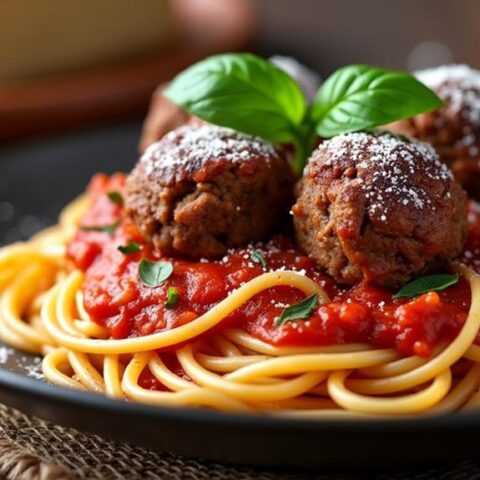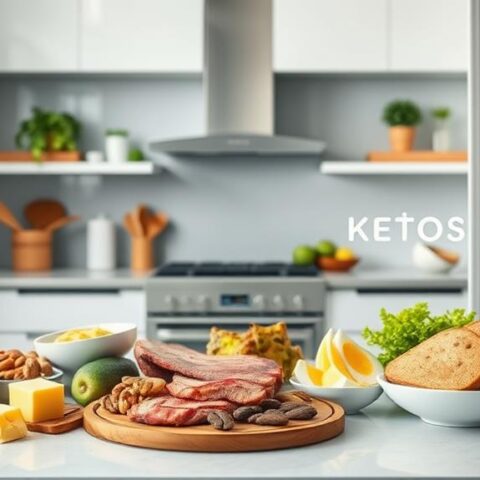
Polenta is not keto-friendly due to its significant carbohydrate content and high glycemic index, each serving containing approximately 19.2 grams of net carbs. Such a carbohydrate load exceeds the ketogenic diet's daily allowance of 20 to 50 grams, effectively preventing the metabolic state of ketosis. The high glycemic index of polenta can result in rapid spikes in blood glucose, posing challenges in insulin management, particularly for individuals with insulin sensitivity. With minimal fats and proteins, polenta also diverges from the macronutrient profile essential for a keto regimen. To explore viable low-carb alternatives, there's more to discover.
Key Takeaways
- Polenta has a high carbohydrate content, with approximately 30 grams per cup, exceeding keto-friendly limits.
- Its high glycemic index causes rapid blood glucose spikes, counterproductive for ketogenic diets.
- Polenta provides minimal dietary fiber, low fat, and protein, misaligning with keto macronutrient goals.
- The high net carbs in polenta can disrupt ketosis by consuming much of the daily carb allowance.
- Low-carb alternatives like cauliflower rice offer suitable replacements for keto-friendly meal planning.
Understanding Polenta
Polenta, a staple of Italian cuisine, is primarily composed of cornmeal, which is particularly high in carbohydrates, averaging around 30 grams per cup. Its carbohydrate content poses a significant challenge for those adhering to a ketogenic diet, which emphasizes low daily net carb consumption to maintain ketosis.
A standard serving of polenta contains approximately 19.2 grams of net carbs, surpassing the typical daily limit for individuals on a ketogenic diet. This high carbohydrate content is due to cornmeal's inherent composition, which is characterized by its high glycemic index. The glycemic index of cornmeal can lead to pronounced spikes in blood glucose levels, additionally complicating the maintenance of ketosis.
Similar to other high-carb foods like potatoes and refined carbohydrates, polenta can disrupt ketosis due to its rapid conversion to glucose. For those following a ketogenic lifestyle, the ability to maintain ketosis is essential, as it facilitates fat metabolism over carbohydrate utilization.
Moreover, polenta contains only 0.6 grams of dietary fiber per 100 grams, insufficient to counterbalance its carbohydrate content. This deficiency in fiber content further diminishes polenta's compatibility with a ketogenic diet.
Consequently, considering its high carbohydrate content and potential impact on blood sugar, polenta is generally regarded as unsuitable for individuals seeking to adhere to a ketogenic dietary regimen.
Nutritional Breakdown
A detailed examination of the nutritional composition of polenta reveals its significant impact on carbohydrate intake, particularly for those following a ketogenic diet. A typical 100g serving of cooked polenta contains approximately 15 grams of carbohydrates, with net carbs per serving reaching 11.65g.
This high carb content poses a substantial challenge for keto dieters who adhere to a daily carb limit of 20-50g. Consuming even a single cup can provide around 30g of carbohydrates, potentially exceeding the carbohydrate threshold for ketosis maintenance.
Unlike other low-carb diets that allow for more flexibility, the Keto diet requires strict adherence to carbohydrate limits to maintain ketosis. Polenta's nutritional profile also complicates its fit within a ketogenic framework. It has a low dietary fiber content, only 0.6g per 100g serving, which can lead to less satiety and a higher likelihood of increased carbohydrate consumption.
Moreover, polenta is low in carbs compared to other grains but remains incompatible with keto due to its high glycemic index, which can cause blood sugar spikes.
Additionally, polenta is characterized by minimal fat (1.84g) and protein (1.11g) content, diverging from the ketogenic diet's high-fat, moderate-protein paradigm. Consequently, polenta's macronutrient distribution does not support the metabolic goals of a ketogenic diet.
Keto Diet Basics
Given the carbohydrate-rich nature of polenta, it becomes evident why it is incompatible with a ketogenic diet—a dietary regimen fundamentally designed around low carbohydrate consumption. The ketogenic diet's primary aim is to induce ketosis, a metabolic state where the body efficiently burns fat for fuel due to restricted carbohydrate intake. Typically, this involves limiting daily net carb consumption to 20 to 50 grams of total carbohydrates. This restriction is vital for maintaining ketosis and promoting weight loss, as research indicates keto dieters can lose over twice the weight compared to low-calorie, low-fat diets.
Additionally, ketosis lowers ghrelin levels, the hunger hormone, leading to decreased appetite.
The ketogenic diet emphasizes foods that are high in protein and fats, such as meats, dairy, nuts, seeds, and healthy oils, while largely excluding grains, sugars, and high-carb fruits. These dietary choices provide the necessary energy through fats instead of carbohydrates. For those adhering to this diet, low-carb alternatives to carbohydrate-dense foods like polenta are essential to maintain dietary compliance.
Individuals on a strict ketogenic diet can optimize their nutritional intake by employing a keto macros calculator. This tool aids in tracking daily nutrient consumption, ensuring the balance of proteins, fats, and carbohydrates aligns with the ketogenic goals. This precise monitoring can enhance the effectiveness of the ketogenic diet in achieving desired health outcomes.
Carbs in Polenta
Understanding the carbohydrate content in polenta is fundamental for those evaluating its place in a ketogenic diet. Polenta, derived from cornmeal, is inherently high in carbs, with approximately 15g of total carbohydrates per 100g serving. This substantial carb count is critical for individuals adhering to a ketogenic diet, which typically restricts daily carbohydrate intake to around 20-50g to maintain ketosis.
In addition, maintaining steady blood sugar levels is essential for those on keto, and polenta's high glycemic index undermines this stability. A standard serving size of cooked polenta, roughly one cup, contains around 30g of carbohydrates, considerably surpassing the daily carb threshold for those on a ketogenic regimen.
The net carbs in polenta, calculated by subtracting fiber from total carbohydrates, are approximately 11.65g per 100g. Despite this reduction, the net carb content remains high enough to potentially disrupt ketosis, a metabolic state characterized by raised ketone levels.
Moreover, polenta's high glycemic index contributes to rapid spikes in blood glucose, undermining the stability of blood sugar levels essential for keto dieters. Such variations in glucose can impede the body's ability to remain in ketosis, which highlights the incompatibility of polenta within a ketogenic framework.
Consequently, the high carbohydrate and glycemic properties render polenta unsuitable for those pursuing a ketogenic lifestyle.
Ketosis and Carbohydrates
Ketosis is a metabolic state that signifies the body's change from using carbohydrates as its primary energy source to relying on fat. This shift necessitates a substantial reduction in carbohydrate intake, facilitating the production of ketones, which are utilized for energy.
To achieve and sustain ketosis, individuals adhering to ketogenic diets typically restrict their daily carb allowance to between 20 to 50 grams. Consuming foods high in carbs, such as polenta, poses a challenge to maintaining this metabolic state.
Polenta's carbohydrate content can disrupt ketosis by increasing blood sugar levels, similar to the effects of excess protein.
High net carbs: Polenta contains approximately 11.65 grams of net carbs per 100 grams cooked, rapidly consuming a significant portion of one's daily carb allowance on a keto diet. Foods with a high glycemic index, like polenta, contribute to raised blood sugar levels, further impeding the achievement of ketosis.
To remain in ketosis, individuals must prioritize low-carb alternatives to high-carb foods, ensuring their carb intake remains within the prescribed limits.
Polenta's Effect on Blood Sugar
Polenta's composition, mainly from cornmeal, results in a high glycemic index, which can precipitate rapid elevations in blood glucose levels.
For individuals following low-carb diets like the ketogenic diet, monitoring blood sugar and ketones is vital to avoid complications such as hypoglycemia.
Such spikes in blood sugar pose significant challenges for individuals managing diabetes or prediabetes, as they can exacerbate insulin resistance over time.
Consequently, the inclusion of polenta in diets should be carefully considered, particularly for those adhering to carbohydrate-restricted regimens like ketogenic diets.
High Glycemic Impact
How does polenta impact blood sugar levels? Polenta, derived from cornmeal, possesses a high glycemic index that contributes to a rapid rise in blood glucose upon ingestion. A standard serving of cooked polenta contains approximately 30 grams of carbohydrates, which is substantial for individuals concerned with managing blood sugar, particularly those with insulin sensitivity.
This high net carb content is counterproductive for those adhering to a keto diet, as it potentially disrupts ketosis by promoting insulin secretion.
The consumption of polenta leads to several physiological responses that may compromise metabolic health:
- Rapid Blood Sugar Increase: Polenta's high glycemic index results in swift glucose absorption, leading to heightened blood sugar levels.
- Insulin Spike: The carbohydrate density triggers an insulin response, essential for glucose regulation but detrimental for achieving steady blood glucose levels.
- Energy Fluctuations: Initial energy surges are often followed by a crash, causing instability in energy and hunger sensations.
For those on a ketogenic diet, the high glycemic impact of polenta poses challenges in maintaining ketosis, as the insulin response negates the metabolic shift necessary for fat oxidation.
Consequently, polenta's carbohydrate profile and glycemic properties render it unsuitable for keto-friendly dietary plans.
Blood Sugar Spikes
Understanding the glycemic impact of various foods is essential for those managing blood sugar levels, particularly individuals with insulin sensitivity or diabetes. Polenta, primarily composed of cornmeal, is high in carbohydrates, containing approximately 30 grams per cup. This substantial carbohydrate content greatly impacts blood sugar, posing challenges for individuals working to maintain glucose stability.
The high glycemic index of polenta facilitates rapid spikes in blood sugar levels, particularly when consumed in larger portions. Such elevations in glucose levels necessitate increased insulin production, which can be problematic for those with compromised insulin sensitivity.
For individuals adhering to a ketogenic diet, where minimizing carbohydrate intake is vital to maintain ketosis, polenta's carbohydrate profile is particularly concerning. A standard serving of polenta contains around 19.2 grams of net carbs, potentially exceeding the daily net carb limit for keto practitioners, thus disrupting ketosis.
The rapid digestion of carbohydrates in polenta can lead to fluctuations in blood sugar, resulting in energy crashes and complicating glucose management. Consequently, for those aiming to maintain stable blood sugar levels or adhere to a low-carb lifestyle, polenta presents considerable challenges, making it an unsuitable dietary choice.
Low-Carb Alternatives
Cauliflower rice is emerging as a viable low-carb substitute to traditional polenta, with its minimal net carbohydrate content of 2.97 grams per 100 grams supporting ketogenic dietary frameworks.
Additionally, it is rich in beneficial antioxidants similar to those found in zucchini noodles, contributing to overall health.
Almond meal offers a versatile, low-carb option with 3 grams of net carbs per 28 grams, enhancing recipes with its unique nutty flavor.
These alternatives not only adhere to ketogenic principles but also provide essential nutrients, supporting metabolic health and dietary satisfaction.
Cauliflower Rice Benefits
Remarkably, cauliflower rice stands out as a superior low-carb alternative to traditional polenta, offering only about 5 grams of net carbohydrates per cup compared to polenta's 30 grams. This low net carb consumption makes cauliflower rice an excellent choice for those adhering to a ketogenic diet, where maintaining low carb intake is critical.
Not only does cauliflower rice aid in reducing grams of net carbs, but it also offers a creamy consistency that can seamlessly replace polenta in various culinary applications.
- Nutrient-Rich: High in vitamins C and K, cauliflower rice contributes to overall health while adhering to low carb dietary requirements.
- Versatile Flavors: Its ability to absorb spices allows cauliflower rice to be integrated into diverse dishes, enhancing meal variety without compromising on carb limits.
- Caloric Efficiency: With approximately 25 calories per cup, cauliflower rice supports larger serving sizes, making it an excellent option for those managing calorie and carbohydrate intake.
Moreover, the preparation of cauliflower rice is both simple and expedient, requiring minimal cooking time.
This convenience, combined with its health benefits, positions cauliflower rice as a prime choice for individuals prioritizing nutritional efficiency and dietary compliance in their daily meals.
Almond Meal Uses
Almond meal, a nutrient-dense flour alternative, is increasingly recognized for its low-carb profile, making it an essential ingredient in ketogenic and gluten-free baking. With only 3 grams of total carbs and 1 gram of net carbs per 2-tablespoon serving, almond meal provides a substantial reduction in carbohydrate intake compared to traditional flours.
Its compatibility with high-fat foods, offering approximately 14 grams of fat per serving, aligns seamlessly with the macronutrient distribution favored by ketogenic diets.
Utilizing almond meal in a 1:1 ratio to replace regular flour guarantees that individuals adhering to low-carb, keto-friendly diets can enjoy baked goods such as cookies, cakes, and breads without compromising their dietary principles.
Its gluten-free nature further extends its applicability to those with gluten sensitivities or celiac disease. Recipes like almond flour pancakes and low-carb blueberry muffins effectively leverage the texture and flavor of almond meal, resulting in palatable alternatives to conventional carbohydrate-laden counterparts.
To optimize moisture and texture in baked goods, almond meal is often combined with other low-carb ingredients, such as eggs and cream cheese. This synergistic combination facilitates the creation of satisfying, nutrient-dense foods that adhere to ketogenic dietary standards.
Recipe Ideas for Keto
For those adhering to a ketogenic diet, the challenge is often finding satisfying alternatives to high-carb staples like polenta. Incorporating keto-friendly sweeteners into low-carb recipes can enhance flavor without disrupting ketosis.
One such alternative is cauliflower grits, which offer a similar texture to traditional polenta but are low in net carbs, containing only 2.97 grams per 100 grams. This keto recipe is nutrient-dense, supplying essential vitamins C and K while aiding in maintaining a metabolic state known as ketosis.
Here are some keto-friendly recipe ideas that replace polenta while keeping your carb intake in check:
- Keto Stuffed Peppers: Filled with ground meat and low-carb vegetables, these peppers are best served over cauliflower rice, providing a filling, low-carb meal.
- Keto Cornbread: Using almond flour and sweet corn extract, these muffins contain merely 2 grams of net carbs each, making them an excellent substitute for cornbread-based dishes.
- Zucchini Noodles: Acting as a base for hearty sauces, zucchini noodles mimic the texture of polenta but with considerably fewer carbs.
These recipes not only align with keto guidelines but also guarantee nutritional adequacy and satisfaction, proving that maintaining ketosis doesn't mean compromising on flavor or variety.
Community Feedback
Community feedback has played a significant role in refining keto-friendly alternatives to traditional polenta, underscoring the importance of user-driven innovation in dietary practices.
The collective insights from the keto community emphasize the necessity of low-carb options, such as cauliflower polenta, in achieving nutritional objectives aligned with ketogenic guidelines. Members frequently express their appreciation for such alternatives as they endeavor to maintain low net carb intake, a critical factor in ketogenic diets.
A prominent theme in community discussions is the exploration of ingredient substitutions. Users share their experiences in replacing high-carb components with low-carb alternatives, with cauliflower emerging as a popular substitute for cornmeal in polenta-like dishes. These adaptations demonstrate not only creativity but also a commitment to preserving the cultural essence of traditional recipes within keto-friendly parameters.
Additionally, the community exchange extends to flavor enhancement techniques. For instance, the use of Amoretti Corn Flavoring is highlighted as an effective strategy to enhance the taste profile of keto recipes without exceeding carb restrictions.
This collaborative environment fosters recipe development and refinement, with discussions focusing on variations in cheese types and additional flavorings to cater to diverse palates while adhering to ketogenic dietary standards.
Making Keto-Friendly Choices
Steering through the intricacies of a ketogenic diet necessitates strategic food selections, particularly when traditional staples like polenta are high in carbohydrates. Maintaining ketosis requires limiting daily carbohydrate intake to 20-50 grams, making it crucial to seek low-carb alternatives.
A 100g serving of cooked polenta contains approximately 15g total carbohydrates and 11.65g net carbs, a considerable portion of the daily allowance. Consequently, substituting polenta with low-carb options is vital for compliance with keto guidelines.
Incorporating keto-friendly vegetables, such as cauliflower, can be a beneficial strategy due to their low net carb content and nutritional benefits. Utilizing ingredients such as cauliflower grits or almond flour, which provide similar textures with markedly fewer net carbs per serving, can be advantageous.
Additionally, incorporating keto-friendly components like heavy cream and parmesan cheese can transform traditional dishes while maintaining low carbohydrate levels. These modifications not only preserve the culinary experience but guarantee adherence to ketogenic principles.
To aid in making informed dietary choices, employing a keto macros calculator is recommended. This tool facilitates tracking daily intake, allowing for precision in maintaining macronutrient balance.
- Cauliflower grits: A versatile, low-carb alternative to polenta.
- Almond flour: Provides texture with reduced net carb content per serving.
- Parmesan cheese: Enhances flavor without increasing carb load.
Frequently Asked Questions
Is Polenta Ok for Keto?
Polenta is not suitable for keto due to its high carbohydrate content, which affects carb counting and ketosis. For meal planning under dietary restrictions, consider keto alternatives like cauliflower rice. Additionally, explore gluten-free options with lower carb profiles.
Is Polenta a Bad Carb?
Polenta's nutritional profile, characterized by a high glycemic index and derived from corn varieties, indicates it as a high-carb option. Alternative grains and mindful cooking methods with controlled portion sizes are advisable for maintaining ideal health outcomes.
Why Isn T Corn Keto Friendly?
Corn, irrespective of its varieties, is not keto-friendly due to high carbohydrate content, impacting ketosis. Corn nutrition includes a high glycemic index, affecting blood sugar. Consider corn alternatives like cauliflower for better digestion and optimized health.
Is Polenta Low-Carb Than Potatoes?
Polenta nutritional facts indicate it is higher in carbohydrates compared to potatoes. A standard polenta serving size reveals more carbs than potatoes, despite polenta health benefits and diverse cooking methods. Unlike rice, its dietary uses vary.
Conclusion
Polenta, a cornmeal-based dish, is not keto-friendly due to its high carbohydrate content, which conflicts with the low-carb requirements of a ketogenic diet. The consumption of polenta can hinder the metabolic state of ketosis, essential for the efficacy of the keto diet. Understanding the nutritional composition of polenta underscores the need for low-carb alternatives to align with keto dietary goals. Exploring such alternatives and adhering to keto principles can facilitate better dietary adherence and health outcomes.










No Comments